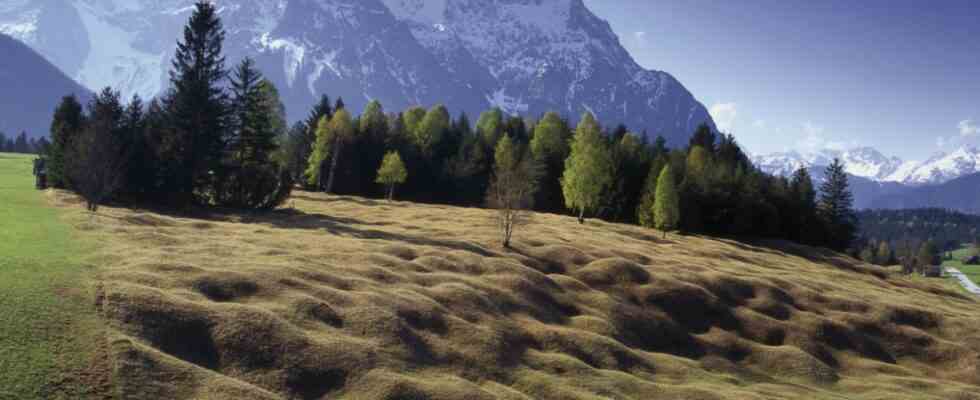The title of the application already shows how much and how many would have to be reconciled: The Garmisch-Partenkirchen district wants larger parts of its “Alpine and pre-Alpine meadows, pastures and moorland landscapes in the Ammergau, Staffelsee area and Werdenfelser Land”. area under the protection of Unesco. All the moors, alpine pastures and humpback meadows are to become World Heritage sites – with a strong emphasis on culture. After all, most farmers in the Werdenfelser Land region don’t need to bother with the word “natural heritage”, i.e. possibly with even more regulations on nature conservation.
In addition, this landscape is not in any way unspoilt, but shaped by pastoralism that has hardly changed over the centuries. However, whether or not anything will change in all of this due to the desired World Heritage status is disputed in the district. Some farmers fear that they will soon no longer be able to pass on their land and grazing rights to the next generation, but will have to leave it to all of humanity. Seven of them have therefore complained to the administrative court in Munich against the application – initially without success, the court dismissed the lawsuit.
Five of the seven plaintiffs own land that is part of the World Heritage application, and two plaintiffs hold grazing rights on such land. This centuries-old system of grazing rights and grazing cooperatives is expressly part of what the district wants to protect as a world heritage site. Together with the extensive moor areas, for example in the Murnauer Moos, the alpine pastures and pastures from the application cover more than 20,000 hectares and thus a good fifth of the district. But by no means all farmers were convinced. Some managed through their communities that their areas were not included, and the Eschenlohe community ultimately refused the project altogether. Others, including the plaintiffs, saw no way of removing their areas from the World Heritage application. Because the district office doesn’t want to have the landscape to be protected cut up too much.
District Administrator Anton Speer (FW) walked through the town halls and taverns with some officials from the alpine farming association and the farmers’ association to promote the project in meetings. It is not primarily about a new advertising sign for tourism, but about preserving the traditional way of doing business, as Speer, who is a part-time farmer himself, always emphasized. At the meetings, the district administrator was happy to nurture the hope that the farmers with World Heritage status could stick to the old tethered system for their cows and that they could also defend their traditional alpine farming by force of arms against the wolf, which they had mentally zeroed in on to have. In reality, they can hardly count on any support from Unesco on either issue.
District Administrator Anton Speer from the Free Voters is a part-time mountain farmer and a big advocate of the World Heritage application.
(Photo: Angelika Warmuth/dpa)
The seven plaintiffs, one of whom was represented by Murnau CSU district councilor Rudolf Utzschneider, also fear that the whole application could only be a kind of trick to actually put more areas under nature conservation via world heritage and monument protection . Because Germany has made an international commitment to ensure the protection of world heritage, some see themselves downright dispossessed. Because they fear they will no longer be allowed to build a new farm or a machine hall on the land, despite the usual agricultural building privilege. In the end, would you even be able to force them to actually exercise their grazing rights in order to preserve the World Heritage landscape?
On Tuesday, however, the presiding judge expressed great doubt that all of these concerns would lead to a right to sue before the administrative court. Accordingly, it is at least questionable whether the district or the Free State really has to ask every landowner and grazing rights activist individually whether they want their area to be part of a World Heritage application. With such an application – unlike in a municipal development plan procedure – there are no regulated rights of participation that could have been violated.
Against whom should the lawsuit be directed?
In addition, the chamber first had to work out who the right defendant could be: the district from which the application originated, or the Free State, whose then Minister of Science Bernd Sibler (CSU) signed the papers. Then District Administrator Speer personally brought the almost 1,000-page application book to the Federal Foreign Office in Berlin, which submitted the application to Unesco in Paris on January 18. The Ministry of Science expects an initial assessment by the experts sometime in the coming year.
The administrative court, on the other hand, closed the case after almost exactly one year. Because the first lawsuit from then five landowners was received at the end of November 2021 – i.e. before the application was submitted. However, because this is now in Paris, the question arose as to whether the whole legal dispute might not have been settled by that. But the district could withdraw its application again – and the Free State, as the responsible Ministerialrat signaled in court, would then probably withdraw from the application. However, neither of them think about that – especially not after the judgment published a few hours later, but not yet justified in detail, according to which the lawsuit is dismissed. A sequel could follow. The plaintiff’s lawyer expressly considers the question of the right to sue to be “a fundamental legal issue that must be discussed in higher instances in any case”.

